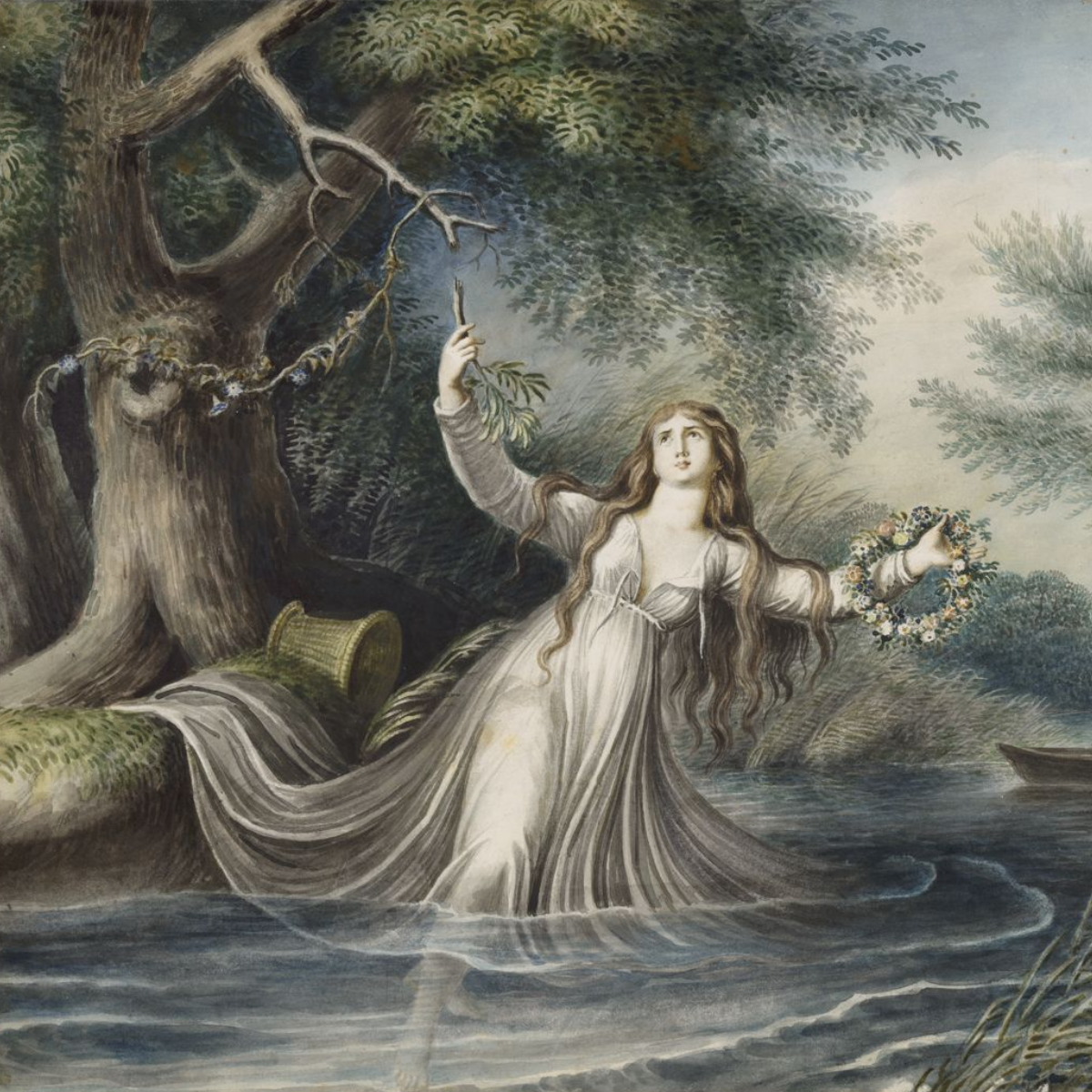This month we explore a folktale referenced by the character Ophelia in William Shakespeare’s Hamlet. It is a follow-on to the owl folklore and the story of Blodeuwedd, which we looked at last month. If you’re new to my blog—welcome! Click here to read last month’s article on owl folklore.
If you aren’t familiar with Hamlet, it was first published in 1603, but most modern editions use a combination of text from two later versions published in 1604 and 1623. It is a murder and revenge tragedy, in which Shakespeare explores topics like sexuality, gender, religion, death, and betrayal while simultaneously examining the psychological health of his characters.
But today, our focus isn’t the whole play—rather just a line spoken by Ophelia as her mental health begins to decline.

“They Say the Owl Was a Baker’s Daughter”
In act 4, scene 5 of Hamlet, Queen Gertrude receives news that Ophelia’s mental health is deteriorating. Ophelia enters the scene shortly after, singing bits of old songs. King Claudius greets her, and Ophelia answers him by saying:
Well, God dild [yield, i.e., reward] you. They say the owl was a
baker’s daughter. Lord, we know what we are but
know not what we may be. God be at your table. (4.5.47-9)
From a folklore standpoint, we are most interested in Ophelia’s statement of, “They say the owl was a baker’s daughter.” In this she is referring to a folktale where Christ enters a baker’s shop in search of bread.
The original source of the folktale is a little murky, but I found essentially the same version in both Folk-Lore of Shakespeare by T. F. Thiselton Dyer and A Dictionary of British Folk-Tales in the English Language, Incorporating the F. J. Norton Collection by Katharine M. Briggs, so I’m going with it. 🙂 I’m quoting the tale from Thiselton Dyer’s book:
Our Saviour went into a baker’s shop where they were baking, and asked for some bread to eat; the mistress of the shop immediately put a piece of dough into the oven to bake for him; but was reprimanded by her daughter, who, insisting that the piece of dough was too large, reduced it to a very small size; the dough, however, immediately began to swell, and presently became a most enormous size, whereupon the baker’s daughter cried out, ‘Heugh, heugh, heugh!’ which owl-like noise probably induced our Saviour to transform her into that bird for her wickedness.
Thiselton Dyer notes that while this was a common Gloucestershire tale, there also existed a version of the story in Herefordshire where a faerie enters the baker’s shop instead of Christ.

In my research, I have learned that this folktale falls under the tale type ATU 751A, “The Farmwife is Changed into a Woodpecker.” (A tale type is a recurring plot pattern, which folklorists and scholars use to study and compare folklore narratives.) This particular tale type was found in many different regions in Europe, as well as in a few places in Asia, the US, and South America.
The tale type basically follows the folktale included above with slight variations depending on the region. For example, instead of a baker’s daughter, it might be a farmwife. And there is a range of birds and other animals the woman might be transformed into rather than an owl—she might be changed into a woodpecker, a raven, a bee, or even a tortoise, just to name a few.
And just as there are variations on the tale itself, I have found that there are many different interpretations of why Ophelia might remark that “the owl was a baker’s daughter.”
Reflecting on England’s Medieval Catholic Past and the Reformation
In “Ophelia’s ‘Old Lauds’: Madness and Hagiography in Hamlet,” Alison A. Chapman argues that as Ophelia’s mental health declines, she begins alluding to medieval Catholicism and “other pre-Reformation religious folklore.” This includes the story of the baker’s daughter. Chapman explains:
This story is characteristic of medieval religion not only in what the Reformation would later deem its superstitious, extrabiblical element (especially the girl’s transmogrification) but also in its anachronistic depiction of Christ walking into what seems to be a medieval European shop.
For the medieval Catholic, the story would have been seen as literal, where Christ really walks into a baker’s shop, warm and filled with the scent of freshly baked bread. Thus, if read on a literal level, the story reflects Ophelia’s state of mind. Chapman notes that “… the baker’s daughter transformed into an owl resembles Ophelia transformed by madness.”
If the folktale is examined through a post-Reformation lens, it might be interpreted in light of spirituality. With the Reformation came the idea of a more spiritual communication with Christ through prayer (as opposed to the concept that you might encounter him in daily life). Chapman writes:
In failing to meet Christ’s need for bread, she [the baker’s daughter] has also rejected his offer of spiritual union, and thus she becomes transformed into an owl, a bird associated with darkness and evil.

As we learned in last month’s post, the owl was seen as an ill-omen in British folklore. Chapman notes that the choices the baker’s daughter makes in the story results in a serious consequence—her transformation into an owl. Similarly, by referencing this folktale, Ophelia may be revealing regret over her own decisions and circumstances, which have contributed to the deterioration of her mental health.
Virginity (Owl) Versus Sensuality (Baker’s Daughter)
I found a different take on Ophelia’s reference to the baker’s daughter in “The Owl and the Baker’s Daughter: A Note on Hamlet IV. v. 42-43” by Robert Tracy. While many scholars and folklorists (as well as my print edition of Hamlet) point to the folktale to explain what Ophelia is alluding to, Tracy offers an alternative viewpoint.
In the play, Ophelia’s sexuality is a frequent topic of discussion during conversations with her father, her brother, and Hamlet. Tracy argues that Ophelia’s line regarding the owl and the baker’s daughter reflects this. He observes: “If the owl suggests one of Ophelia’s concerns, virginity, the ‘baker’s daughter’ suggests another, sensuality and harlotry.”
He explains that the owl, beyond being a portent of bad luck and death, was also “a symbol of virginity.” He further notes that for “Elizabethans, bakers’ daughters were prostitutes.” Apparently, this interrelationship between bakeries and prostitution comes from ancient Rome.
In his article, Tracy suggests that “Ophelia is commenting on appearance and reality” with respect to female sexuality. Most of the old songs she sings during this scene (before and after the owl and baker’s daughter line) explore “virginity and its sacrifice to sensual love.” Tracy proposes that the decline of her mental health is due in part to the stress of trying to reconcile these two very different models of female behavior with respect to sex.
A Foreshadowing of Ophelia’s Death
Just two scenes after Ophelia references the baker’s daughter tale, we learn of her death from Queen Gertrude. Gertrude explains that Ophelia has drowned, having “Fell in the weeping brook” (4.7.200).

In light of this, the folktale of the baker’s daughter might also be seen as a foreshadowing of Ophelia’s own death. As I discussed in my previous post on British owl folklore, owls were often considered to be death portents. Robert Tracy notes this in his paper; however, he connects the owl as a death omen to Ophelia’s thoughts of her father’s recent death.
But if we look at the tale of the baker’s daughter in a parallel light to the story of Blodeuwedd, we might also interpret their transformation into owls as symbolic of their deaths. In last month’s article I wrote:
Blodeuwedd’s transformation into an owl links the bird to death once more. John Rhŷs, in Celtic Folklore: Welsh and Manx, explains that for both Blodeuwedd and Lleu [her husband], when they are changed into birds, it is considered to be their deaths.
In the preface to his book, Thiselton Dyer explains that Shakespeare had “an intimate acquaintance with the folk-lore of bygone days.” While I could not ascertain if Shakespeare would have known Blodeuwedd’s story, Thiselton Dyer does note that Shakespeare was familiar with the idea of the transmigration of souls. (This is the concept that after death the soul passes into another being, including animals.) He writes: “Shakespeare has several references to the old superstitious belief in the transmigration of souls, traces of which may still be found in the reverence paid to the robin, the wren, and other birds.” He then cites the story of the baker’s daughter as an example.
So on two levels the folktale might serve as a foreshadowing of death—through the owl’s folkloric associations and through the young woman’s transformation into an owl.
Hamlet Offers Many Interpretations
In Michael Neill’s “A Modern Perspective: Hamlet,” he notes that not only is Hamlet a revenge drama and psychological study, but it is also “a prolonged meditation on death.” How we resonate with the play and characters depends on how we respond to these different layers while bringing in our own knowledge and experience.
As a result, the play, the characters, and even a single line can offer many interpretations. I’ve always been fascinated by Hamlet. It’s a play that provides mystery and riddles, and seems to ignite the imagination. Neill writes:
… [Hamlet] has developed a reputation as the most intellectually puzzling of his plays, and it has already attracted more commentary than any other work in English except the Bible. Even today, when criticism stresses the importance of the reader’s role in “constructing” the texts of the past, there is something astonishing about Hamlet’s capacity to accommodate the most bafflingly different readings.
If you’d like to read more about Shakespeare and folklore, I have an earlier post that explores Puck (who comes from faerie folklore) in A Midsummer Night’s Dream.
As ever, thank you for reading my blog. If you know someone fascinated by folklore and folktales, feel free to share this post with them.
PS: Barb DeLong, an author in my writing group, just released the second book in her romantasy series! It’s called The Keeper’s Code. Congrats, Barb! If you enjoy fantasy romance, you should check out her books.
Art credit (featured image): Hamlet, IV, 7, Ophelia falling into the water by Johann Heinrich Ramberg via Folger Shakespeare Library Digital Collections, licensed under CC0




